|
Park Miniatúr
Park miniatúr is a miniature park in Podolie, Slovakia. It displays 32 miniature models of architecture from Slovakia, built at a ratio of 1:25 and 1:50. The park was established on 25 October 2003. In the final form of park, there will be 80 miniature models. A small selection of the models: * Čachtice Castle, Čachtický hrad * Tematín * Svätý Kríž * Nový zámok, Nový zámok Banská Štiavnica * Červený Kameň Castle, Červený Kameň References External links * {{DEFAULTSORT:Park miniatur Parks in Slovakia Miniature parks Buildings and structures in Trenčín Region Tourist attractions in Trenčín Region ... [...More Info...] [...Related Items...] OR: [Wikipedia] [Google] [Baidu] |
Miniature Park
A miniature park is a display of miniature buildings and models, usually as a recreational and tourist attraction open to the public. A miniature park may contain a model of a single city or town, often called a miniature city or model village, or it can contain a number of different sets of models. History There is evidence to suggest the existence of private model villages and miniature parks since the 19th century, but it was only in the 1930s to 1950s that the genre became tourist attractions. Early examples include Bekonscot and Bourton-on-the-Water in the UK and Madurodam in The Hague. Variations on a theme Most model villages and parks are built to a consistent scale; varying from 1:76 as used by the intricately detailed Pendon in England up to the 1:9 scale of Wimborne Model Town. There has been a move away from the model village concept since the mid- to late 20th century towards a miniature park concept. Model villages are typically larger-scale, sit in a cohesive ... [...More Info...] [...Related Items...] OR: [Wikipedia] [Google] [Baidu] |
Podolie
Podolie () is a village and municipality in Nové Mesto nad Váhom District in the Trenčín Region of western Slovakia. History In historical records the village was first mentioned in 1332. Before the establishment of independent Czechoslovakia in 1918, Podolie was part of Nyitra County within the Kingdom of Hungary. From 1939 to 1945, it was part of the Slovak Republic. Geography The municipality lies at an altitude of 180 metres and covers an area of 17.266 km2. It has a population of about 2056 people. Miniature park Podolie is the site of Park miniatúr Park miniatúr is a miniature park in Podolie, Slovakia. It displays 32 miniature models of architecture from Slovakia, built at a ratio of 1:25 and 1:50. The park was established on 25 October 2003. In the final form of park, there will be 80 min ..., a miniature park. References External links Villages and municipalities in Nové Mesto nad Váhom District {{Trenčín-geo-stub ... [...More Info...] [...Related Items...] OR: [Wikipedia] [Google] [Baidu] |
Čachtice Castle
Čachtice Castle (; , ) is a castle ruin in Slovakia next to the village of Čachtice. It stands on a hill featuring rare plants, and has been declared a national nature reserve for this reason. The castle was a residence and later the prison of the Countess and alleged serial killer Elizabeth Báthory. Čachtice was built in the mid-13th century by Kazimir from the Hont-Pázmány gens as a sentry on the road to Moravia. Later, it belonged to Matthew III Csák, Matthew Csák, the Stibor of Stiboricz, Stibor family, and then to Elizabeth Báthory. Čachtice, its surrounding lands and villages, was a wedding gift from the Nádasdy family upon Elizabeth's marriage to Ferenc Nádasdy in 1575. Originally, Čachtice was a Romanesque architecture, Romanesque castle with an interesting horseshoe-shaped residence tower. It was turned into a Gothic architecture, Gothic castle later and its size was increased in the 15th and 16th centuries. A Renaissance renovation followed in the 17th cent ... [...More Info...] [...Related Items...] OR: [Wikipedia] [Google] [Baidu] |
Tematín
Tematín Castle is a castle ruin in western Slovakia. History The castle was originally built in the second half of the 13th century in the Kingdom of Hungary. It was completely reconstructed by the Thurzó family, owners of the castle from 1524. The last owner was Miklós Bercsényi, general of the anti-Habsburg insurrection army during Rákóczi's War of Independence. The castle fell into ruins after it was besieged in 1710 as a part of the suppression of the anti-Habsburg uprising. A trove of axe-shaped iron coins from the Great Moravian period was found in the Hrádok area. Traces of the Great Moravian fortified settlement found in the village were destroyed by construction activities. Conservation Today there is a Tematin castle non-profit organizationOZ Hrad Tematin composed of university students. They work on conservation projects, conduct archaeological research and other historical-architectural research and other activities for castle preservation as well as making t ... [...More Info...] [...Related Items...] OR: [Wikipedia] [Google] [Baidu] |
Svätý Kríž
Svätý Kríž () is a village and municipality in Liptovský Mikuláš District in the Žilina Region of northern Slovakia. History In historical records the village was first mentioned in 1277. Before the establishment of independent Czechoslovakia in 1918, it was part of Liptó County within the Kingdom of Hungary. From 1939 to 1945, it was part of the Slovak Republic. Geography The municipality lies at an altitude of 630 metres and covers an area of 9.413 km2. It has a population Population is a set of humans or other organisms in a given region or area. Governments conduct a census to quantify the resident population size within a given jurisdiction. The term is also applied to non-human animals, microorganisms, and pl ... of about 687 people. References External links * http://www.statistics.sk/mosmis/eng/run.html Villages and municipalities in Liptovský Mikuláš District Liptov {{Žilina-geo-stub ... [...More Info...] [...Related Items...] OR: [Wikipedia] [Google] [Baidu] |
Nový Zámok
Nový zámok (literally "New Castle") is a castle in Banská Štiavnica, Slovakia. The castle is located on a hill south of the city center at an altitude of 630m above sealevel, marking the highest point of the city center. History After the defeat of the Hungarian troops by the Ottoman army in the battle of Mohács in 1526, defences in more northern places in Hungary needed to be reinforced with new defensive structures. Shortly after the northern mining region started defence preparations as the region was a great resource of precious metals at that time. In 1541 the town council decided on the fortification of Selmeczbánya. New Castle – a national cultural monument – is a six-floor Renaissance The Renaissance ( , ) is a Periodization, period of history and a European cultural movement covering the 15th and 16th centuries. It marked the transition from the Middle Ages to modernity and was characterized by an effort to revive and sur ... building with four ... [...More Info...] [...Related Items...] OR: [Wikipedia] [Google] [Baidu] |
Červený Kameň Castle
Červený Kameň Castle (, , ) is a 13th-century castle in southwestern Slovakia in the Little Carpathians near the village of Častá. History A stone castle was built by Tiburtius Rosd or his descendants in the 13th century as part of the chain of the Kingdom of Hungary’s frontier defense castles ranging from Pressburg to Žilina (). This castle was completely rebuilt as a fortress in the first half of the 16th century. When the Pálffy family acquired the castle in 1588, the fortress was completed, and it became a representative noble castle. Although the castle was damaged several times by fire, it was always reconstructed by the Pálffys, who were the owners of the castle until the Second World War. Today, the castle is a museum. See also * List of castles in Slovakia This is a list of castles in Slovakia. This list includes palaces, citadels and manor houses. These Slovak language, Slovak words translate as follows: #''hrad'', ''hrádok'' - castle #''zámok'' - co ... [...More Info...] [...Related Items...] OR: [Wikipedia] [Google] [Baidu] |
3 Cschtice Kostoliky
3 (three) is a number, numeral and digit. It is the natural number following 2 and preceding 4, and is the smallest odd prime number and the only prime preceding a square number. It has religious and cultural significance in many societies. Evolution of the Arabic digit The use of three lines to denote the number 3 occurred in many writing systems, including some (like Roman and Chinese numerals) that are still in use. That was also the original representation of 3 in the Brahmic (Indian) numerical notation, its earliest forms aligned vertically. However, during the Gupta Empire the sign was modified by the addition of a curve on each line. The Nāgarī script rotated the lines clockwise, so they appeared horizontally, and ended each line with a short downward stroke on the right. In cursive script, the three strokes were eventually connected to form a glyph resembling a with an additional stroke at the bottom: ३. The Indian digits spread to the Caliphate in the 9th ... [...More Info...] [...Related Items...] OR: [Wikipedia] [Google] [Baidu] |
Parks In Slovakia
A park is an area of natural, semi-natural or planted space set aside for human enjoyment and recreation or for the protection of wildlife or natural habitats. Urban parks are green spaces set aside for recreation inside towns and cities. National parks and country parks are green spaces used for recreation in the countryside. State parks and provincial parks are administered by sub-national government states and agencies. Parks may consist of grassy areas, rocks, soil and trees, but may also contain buildings and other artifacts such as monuments, fountains or playground structures. Many parks have fields for playing sports such as baseball and football, and paved areas for games such as basketball. Many parks have trails for walking, biking and other activities. Some parks are built adjacent to bodies of water or watercourses and may comprise a beach or boat dock area. Urban parks often have benches for sitting and may contain picnic tables and barbecue grills. The largest ... [...More Info...] [...Related Items...] OR: [Wikipedia] [Google] [Baidu] |
Miniature Parks
A miniature park is a display of miniature buildings and model (physical), models, usually as a recreational and tourist attraction open to the public. A miniature park may contain a model of a single city or town, often called a miniature city or model village, or it can contain a number of different sets of models. History There is evidence to suggest the existence of private model villages and miniature parks since the 19th century, but it was only in the 1930s to 1950s that the genre became tourist attractions. Early examples include Bekonscot and Bourton-on-the-Water model village, Bourton-on-the-Water in the UK and Madurodam in The Hague. Variations on a theme Most model villages and parks are built to a consistent scale model, scale; varying from 1:76 as used by the intricately detailed Pendon in England up to the 1:9 scale of Wimborne Model Town. There has been a move away from the model village concept since the mid- to late 20th century towards a miniature park concep ... [...More Info...] [...Related Items...] OR: [Wikipedia] [Google] [Baidu] |
Buildings And Structures In Trenčín Region
A building or edifice is an enclosed structure with a roof, walls and windows, usually standing permanently in one place, such as a house or factory. Buildings come in a variety of sizes, shapes, and functions, and have been adapted throughout history for numerous factors, from building materials available, to weather conditions, land prices, ground conditions, specific uses, prestige, and aesthetic reasons. To better understand the concept, see ''Nonbuilding structure'' for contrast. Buildings serve several societal needs – occupancy, primarily as shelter from weather, security, living space, privacy, to store belongings, and to comfortably live and work. A building as a shelter represents a physical separation of the human habitat (a place of comfort and safety) from the ''outside'' (a place that may be harsh and harmful at times). buildings have been objects or canvasses of much artistic expression. In recent years, interest in sustainable planning and building pract ... [...More Info...] [...Related Items...] OR: [Wikipedia] [Google] [Baidu] |






